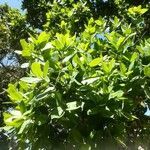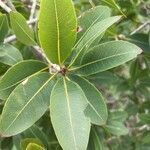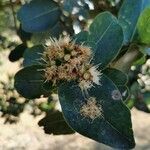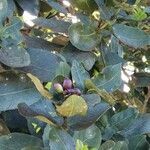Small or medium-sized evergreen tree, 3-15 m high; foliage very dense, slightly glaucous; bark dark brown, rough, flaking; young stems quadrangular, slightly winged. Leaf oblong-elliptic or suborbicular, up to 80 mm long, apex broadly rounded to subacute. Flowers in branched, terminal, corymbose cymes, creamy white to pink, fragrant. Stamens many, fluffy. Flowering time Aug.-May. Fruit an oval berry, ± 18 x 9 mm, purple-black, urceolate, calyx persistent.
Leaf-lamina 4–8 x 2·2–13·5 x 7 cm., lanceolate-elliptic to oblong-elliptic or suborbicular, apex broadly rounded to subacute or, very rarely very shortly subacuminate, or emarginate, base deeply cordate and amplexicaul; petiole up to 0·2 cm. long.
Tree or shrub, up to 10 m high. Branches tetragonous. Leaves opposite, elliptic-cordate. Fruit purple, becoming almost black when ripe. Flowers white to cream.
Receptacle (including pseudopedicel) + calyx 0–6–0–9 cm. long; calyx +upper receptacle 0·35–0·5 cm. long; filaments (0·8)1·1–1·5 cm. long.
Fruit c. 1·8 x 0·9 cm., purple-black, urceolate, persistent calyx + upper receptacle 0·3–0·4 cm. long x 0·5 cm. wide.
Small or medium-sized evergreen tree up to 20 m. tall; foliage very dense, slightly glaucous.
Young stems quadrangular and slightly winged.
Bark dark brown, rough, flaking.





